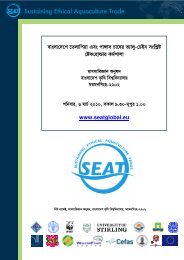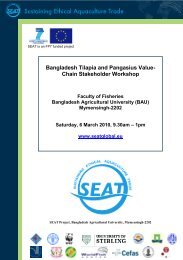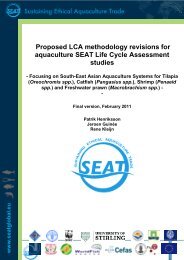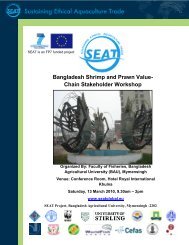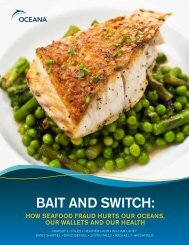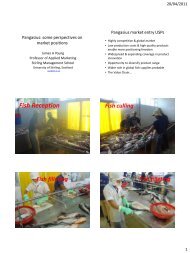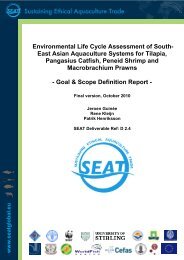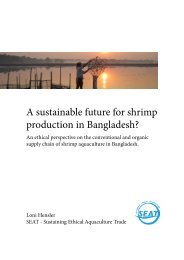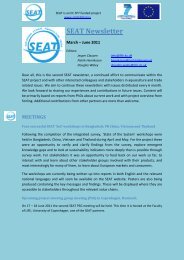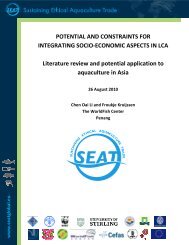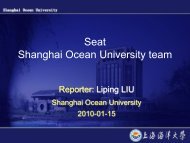D4.1 Review of Environmental Models - SEAT Global
D4.1 Review of Environmental Models - SEAT Global
D4.1 Review of Environmental Models - SEAT Global
Create successful ePaper yourself
Turn your PDF publications into a flip-book with our unique Google optimized e-Paper software.
1.3.10 KK3D<br />
the sea bed and the effect it has upon the benthic fauna. The fourth and final model is the<br />
Water Quality model which is split into two parts; 1) water quality in the Net pen cages<br />
which determines the concentrations <strong>of</strong> O2 and ammonium produced, 2) water quality<br />
discharged to surrounding bodies which is modelled based on the change in turbidity and<br />
oxygen levels due to eutrophication (Stigebrandt et al., 2004).<br />
The MOM model was implemented as part <strong>of</strong> the ECASA project as well as SPEAR as it is<br />
robust and simulates most <strong>of</strong> the factors that can be thought <strong>of</strong> for net pen cage culture<br />
(Stigebrandt et al., 2004). This model is data intensive and can take a long time to develop<br />
for other culture methods and species if data is not available. The model has now been<br />
developed to include shellfish farming (Zhang et al., 2009b).<br />
KK3D is a waste deposition model for use in mariculture, which can be applied to both local<br />
scale and water body scale (SAMS. 2004) The model is object-oriented and developed in<br />
C++. It uses input data for feed composition, geometry <strong>of</strong> net-pens, variation in emissions<br />
over a given time scale, faecal pellet solubility, current velocity, settling rate <strong>of</strong> faecal pellets<br />
and realistic bathymetry data (Jusup et al, 2007) Unlike the deposition model DEPOMOD,<br />
KK3D does not have a resuspension model connected to it (Jusup et al., 2007) It does<br />
however contain a particulate organic matter model which is another particle tracking<br />
module, which determines whether the particle will remain motionless on the seabed or<br />
move again (Jusup et al., 2009). Data required in order to run the model is relatively easily<br />
obtainable at minimal cost as it requires only daily datasets (Jusup et al., 2007).<br />
Table 1.2: Summary description <strong>of</strong> models and model systems relevant to aquaculture<br />
Model Type Package Reference<br />
DEPOMOD Waste Dispersion Visual Basic<br />
Cromey et al., 2002<br />
(Salmon)<br />
(Computer Language)<br />
COD-MOD Waste Dispersion Visual Basic<br />
Cromey et al., 2002<br />
(Cod)<br />
(Computer Language)<br />
MERAMOD Waste Dispersion<br />
(Med)<br />
Borland Delphi 7 SAMS. 2004<br />
FARM Resource management<br />
for shellfish<br />
STELLA Ferreira et al., 2007<br />
APEM <strong>Environmental</strong> ecosystem STELLA Culberson &<br />
dynamics<br />
Piedrahita, 1996<br />
IAAS Evironmental ecosystem STELLA Jamu & Piedrahita,<br />
dynamics<br />
2002 (a&b)<br />
AWATS Waste transport Various Dudley et al., 2000<br />
MMFA Material flow Spreadsheet Schaffner et al.,<br />
2009<br />
SWAT Water quality/<br />
Visual Basic<br />
Spruill et al., 2000<br />
Groundwater modelling (Computer Language)<br />
EcoWin2000 Ecosystem model Ecowin2000 s<strong>of</strong>tware EcoWin website,<br />
2010<br />
MOM <strong>Environmental</strong> impact Hansen et al., 2001<br />
Page 19



